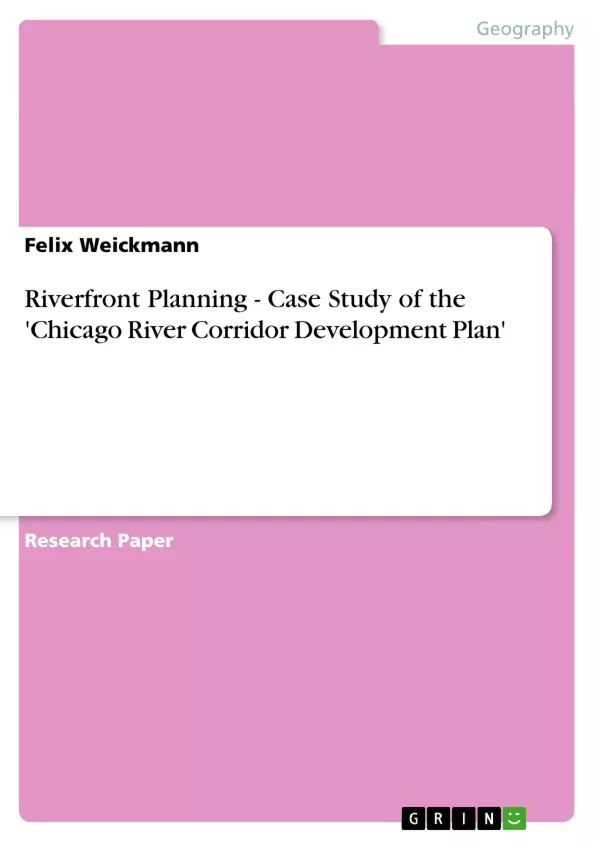In many urban regions, awareness of the specific challenges facing water-connected areas is increasing, and for the last forty years waterfront revitalization has been a hot topic worldwide. This has also been the case in the seven-million citizen region of Chicago. The factories and industries that once lined the Chicago River are now mostly gone (having closed or moved to greenfield sites). Nowadays a new mode of thinking is needed to decide how riverfront areas should best be redesigned and redeveloped. Even in the last few years, awareness of the importance of enhancing the conditions along the Chicago River corridor and developing new valuable urban areas for residential and recreational utilization has grown. In 2005, Chicago’s mayor labeled the river as “Chicago’s second shoreline” and claimed that the river’s banks are no longer “forgotten areas”. Against this political background the following paper investigates the research question:
How does the City of Chicago approach comprehensive planning for the Chicago River Corridor?
To answer this question an analysis of the planning process and a plan assessment is done. The paper proceeds as follows. In the next section is an overview given of the history of the development and utilization of the Chicago River corridor. Sections 3 and 4 discussed the comprehensive plan making process as a basic planning tool and the specific content and features of the Development Plan, respectively. Section 5 presents a critical assessment of the river and riverfront planning approach of the City of Chicago. The paper concludes with suggestions of how planners can improve comprehensive waterfront plans and comprehensive plans in general as well as approach best plan making processes associated with urban riverfront development.
Inhaltsverzeichnis (Table of Contents)
- Acknowledgement
- Introduction
- The Chicago River History
- The Early History and Water-Based Economic Growth
- The Sanitary & Ship Canal, North Shore and Cal-Sag Channel
- The Plan of Chicago and post World War II
- Current Situation - Changing the Image
- The Comprehensive Planning Approach
- Why Planning?
- The Comprehensive Plan
- The Legal Basis
- Elements of the Plan Making Process
- Community Planning Concept
- Planning in a Contemporary Democracy
- Public Participation in the Planning Process
- The Planning Body
- Case Study: The Chicago River Corridor Development Plan
- The Development Plan
- The Goals of the Development Plan
- Reaches and Development Opportunity Sites
- The Implementation Strategies
- Further Plans
- The Development Plan
- The Planning Process
- The Key Players
- Task Forces, Steering Committees, and Public Meetings
- Finances and Leadership
- Assessments and Recommendations
- Key Findings
- Leadership and Political Will
- Public Participation
- Water Quality
- Environmental Education
- Conclusion
- References
- The Interviewed Experts
- Appendix
Zielsetzung und Themenschwerpunkte (Objectives and Key Themes)
This research paper examines the comprehensive planning approach employed in the development of the 'Chicago River Corridor Development Plan.' It analyzes the plan itself, focusing on its goals, implementation strategies, and its interaction with various stakeholders. This research is grounded in the importance of urban riverfront planning and how it is used to address the growing pressure on water-connected areas. The research also seeks to understand how comprehensive planning can contribute to the revitalization of urban waterfronts, ensuring a balanced approach for public and private interests.
- The importance of comprehensive planning in urban riverfront development
- Analyzing the 'Chicago River Corridor Development Plan' as a case study of comprehensive planning
- Exploring the implementation strategies and stakeholders involved in the planning process
- The role of public participation and community engagement in riverfront planning
- Evaluating the plan's effectiveness in addressing the diverse uses of the Chicago River corridor.
Zusammenfassung der Kapitel (Chapter Summaries)
The paper begins by outlining the historical significance of the Chicago River, tracing its evolution from a vital waterway for economic growth to its present-day role as a focal point for urban revitalization. The research then delves into the theoretical framework of comprehensive planning, exploring its key principles and how it is applied in the context of urban waterfronts. The main focus is on the Chicago River Corridor Development Plan, providing a detailed analysis of its goals, implementation strategies, and the major players involved. The final section examines the overall planning process, highlighting key findings, the role of leadership and public participation, and the impact on water quality and environmental education.
Schlüsselwörter (Keywords)
The main keywords associated with this research include comprehensive planning, urban riverfront development, Chicago River Corridor Development Plan, public participation, community engagement, water quality, environmental education, revitalization, and stakeholder involvement.
- Arbeit zitieren
- M.A. Geograph Felix Weickmann (Autor:in), 2006, Riverfront Planning - Case Study of the 'Chicago River Corridor Development Plan', München, GRIN Verlag, https://www.grin.com/document/73662



